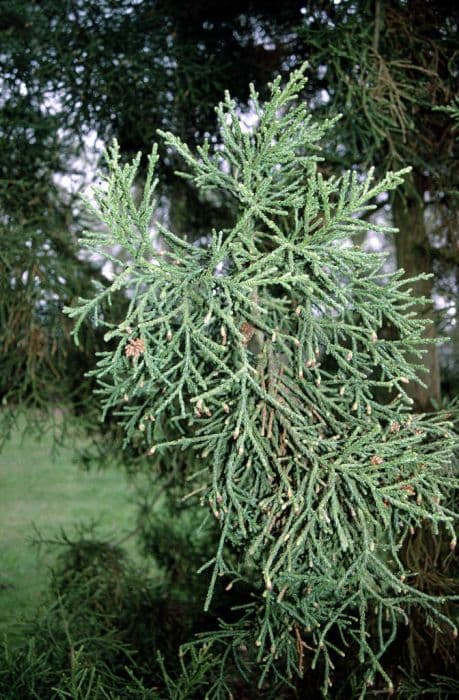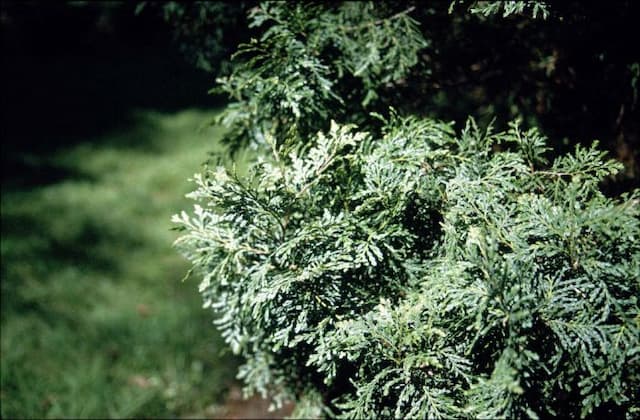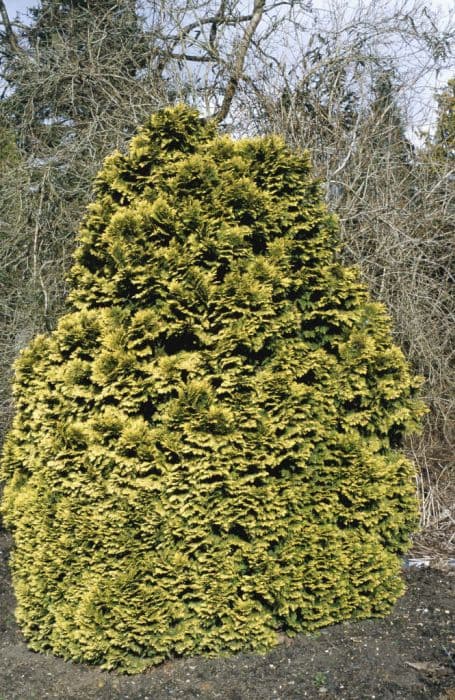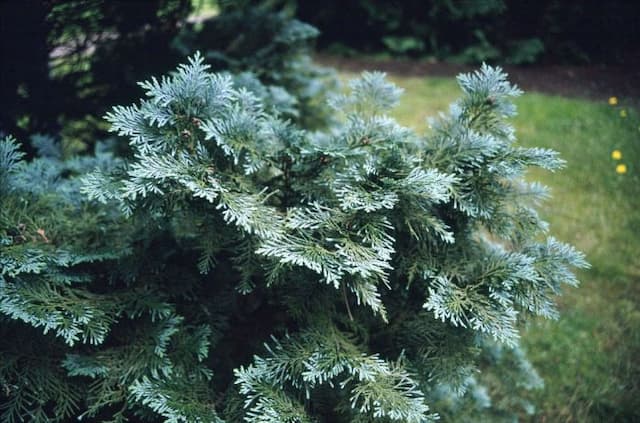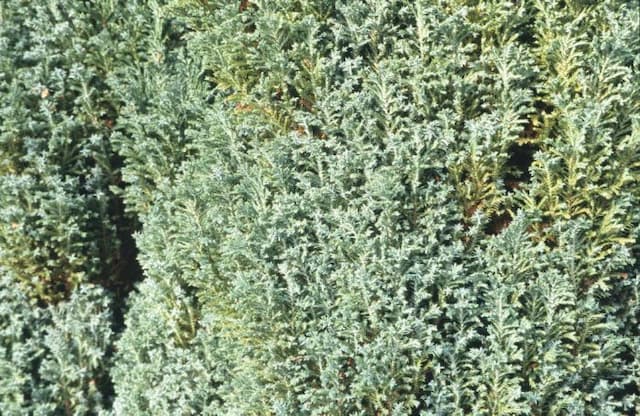Chinese Juniper 'Stricta' Juniperus chinensis 'Stricta'











ABOUT
'Stricta' is a small, compact evergreen conifer with a conical shape. The foliage is soft and bluish when young, maturing to blue-green.
About this plant
 Names
NamesFamily
Cupressaceae
Synonyms
Chinese Juniper, Pencil Juniper
Common names
Juniperus chinensis 'Stricta'.
 Characteristics
CharacteristicsLife cycle
Perennials
Foliage type
Evergreen
Color of leaves
Blue-green
Height
10-15 feet (3-4.5 meters)
Spread
4-6 feet (1.2-1.8 meters)
Plant type
Shrub
Hardiness zones
4-9
Native area
China
Benefits
 General Benefits
General Benefits- Landscape aesthetic: Chinese Juniper 'Stricta' brings a unique, upright form to landscapes, adding vertical lines and texture.
- Drought tolerance: Once established, it has good drought resistance, reducing the need for frequent watering.
- Low maintenance: Requires minimal pruning and care once established, making it an excellent choice for busy gardeners.
- Wildlife support: Offers habitat and food sources for birds and other wildlife.
- Cold hardiness: Can withstand cold temperatures, making it suitable for a variety of climatic conditions.
- Soil adaptability: Adapts to a range of soil types, from clay to sandy soils, provided they are well-draining.
- Windbreak: Its dense foliage can serve as a windbreak, protecting gardens and structures from strong winds.
- Privacy screen: Can be used to create a natural screen for privacy in gardens and outdoor living spaces.
- Year-round interest: Evergreen foliage provides visual interest throughout all seasons.
- Erosion control: Helps prevent soil erosion, especially on slopes, thanks to its root system.
 Medical Properties
Medical Properties- This plant is not used for medical purposes.
 Air-purifying Qualities
Air-purifying QualitiesThis plant is not specifically known for air purifying qualities.
 Other Uses
Other Uses- Juniper wood is often used in creating small decorative items like jewelry boxes, due to its fine grain and aromatic scent, enhancing the appeal of hand-crafted objects.
- The dense foliage of Juniperus chinensis 'Stricta' can be pruned into intricate shapes, making it a popular choice for bonsai or topiary art.
- Juniper branches can serve as a natural insect repellent due to their aromatic oils, which can be placed in wardrobes or drawers to protect clothes.
- In woodworking, the wood of the Juniper can be used for veneer, a decorative and protective finish for fine furniture.
- The compact growth habit of the Juniperus chinensis 'Stricta' makes it useful for creating privacy screens or hedges in residential landscapes.
- Due to its robust nature, the Juniper can be used in erosion control, helping to stabilize soil on slopes or disturbed areas.
- The tree's wood is sometimes used in crafting musical instruments such as specialty flutes or small stringed instruments like ukuleles for a unique sound.
- Juniper ash can be used as a natural glaze in pottery, offering a range of subtle color variations when fired in a kiln.
- In culinary contexts, Juniper wood chips can be used for smoking meats and cheeses, imparting a unique flavor profile.
- The dense wood of Juniper is also suitable for making durable outdoor garden structures like pergolas, arbors, or trellises.
Interesting Facts
 Feng Shui
Feng ShuiChinese juniper can be used in Feng Shui practice to enhance the energy of a space, due to its evergreen nature symbolizing longevity and permanence. Its upward-growing form is also associated with growth and can be positioned in the east sector of a garden or home to promote family harmony and health, according to traditional Feng Shui principles.
 Zodiac Sign Compitability
Zodiac Sign CompitabilityChinese juniper is not used in astrology practice.
 Plant Symbolism
Plant Symbolism- Protection: Junipers are often associated with protection due to their prickly leaves, representing a barrier against harm and negativity.
- Purification: Because of their aromatic properties and historical use in rituals, junipers symbolize cleansing and purification of both the self and the environment.
- Healing: With its antiseptic qualities, the juniper is a symbol of healing, often used in traditional medicine to treat various ailments.
- Longevity: The juniper is known for its long lifespan and durability, which makes it a symbol of long life and the ability to withstand the challenges of time.
- Good Health: The healthy growth and evergreen nature of the juniper plant symbolize good health and vitality.
 Water
WaterThe Chinese Juniper needs to be watered regularly, especially during dry spells, with an emphasis on deep watering to encourage root growth. Young plants should be watered about once a week with approximately 2 gallons per watering session, decreasing frequency as the plant matures and its root system becomes more established. In hot and dry climates, increasing the frequency to twice a week may be necessary. It's important to avoid waterlogging the soil, so ensure the plant is in well-draining soil, and reduce watering in the winter when the plant's growth slows.
 Light
LightChinese Junipers thrive in full sunlight, requiring at least six hours of direct sunlight daily for optimal growth and health. They can tolerate partial shade but will perform best in a spot where they receive unfiltered sunlight throughout the day. They do not do well in deep shade, as this can lead to sparse foliage and weak growth.
 Temperature
TemperatureChinese Junipers are hardy and adaptable to a wide range of temperatures, with an ideal growing range between 60°F to 70°F. They can survive temperatures as low as -20°F, making them suitable for many temperate climates. However, they should be protected from extreme heat, particularly when young, as temperatures consistently above 90°F can stress the plant.
 Pruning
PruningPrune Chinese Junipers to maintain shape, control size, and remove dead or damaged branches. It's best to prune in late winter or early spring before new growth begins, as this helps the plant to heal quickly and minimizes stress. Light shaping can be done throughout the growing season as needed, but always avoid heavy pruning, which can harm the plant.
 Cleaning
CleaningNot needed
 Soil
SoilThe Chinese juniper 'Stricta' prefers a well-draining soil mix, with a pH range of 5.5 to 7.0. A good mixture is one-part peat, one-part pine bark, and one-part coarse sand or perlite; this ensures good drainage while still retaining moisture.
 Repotting
RepottingChinese junipers 'Stricta' should be repotted every 2 to 3 years when young, and less frequently as they mature. It's best to repot in late winter before the growing season starts.
 Humidity & Misting
Humidity & MistingChinese juniper 'Stricta' tolerates a wide range of humidity levels but does best in moderate to low humidity environments typical of its outdoor habitat.
 Suitable locations
Suitable locationsIndoor
Provide bright light, avoid overwatering, and ensure good air flow.
Outdoor
Full sun, well-draining soil, protect from extreme cold.
Hardiness zone
4-9 USDA
 Life cycle
Life cycleJuniperus chinensis 'Stricta', commonly known as the Chinese juniper 'Stricta', begins its life as a seed, which requires well-drained soil and exposure to sunlight to germinate, a process that can be slow and irregular. After germination, the seedling stage follows, during which the plant establishes its root system and begins to develop its characteristic needle-like foliage. As it transitions to the juvenile stage, the plant grows more rapidly, developing a more defined conical shape and denser foliage. Reaching maturity, it can start producing cones; male plants release pollen, while female plants produce berry-like cones containing seeds, which are often spread by birds. The adult Chinese juniper 'Stricta' can live for many years, growing slowly and requiring minimal maintenance, reaching up to 15 feet in height. Eventually, it enters a phase of senescence where growth slows down, and it may become more susceptible to environmental stressors and disease before eventually dying.
 Propogation
PropogationPropogation time
Spring-Early Summer
Propogation: The most popular method of propagating the Chinese Juniper 'Stricta' is through semi-hardwood cuttings. This technique usually takes place in late summer when the current season's growth has begun to mature and harden slightly. A cutting of about 4 to 6 inches (10 to 15 centimeters) is snipped from a healthy parent plant, ensuring a small portion of older wood is included at the base to increase the chances of rooting. Leaves from the lower half of the cutting are removed to expose the nodes, where roots will form. The base of the cutting is then dipped in rooting hormone to facilitate root development and planted in a moist, well-draining medium. It's then placed in a protected environment with indirect sunlight until roots establish, which can take several weeks to a few months, depending on conditions.
